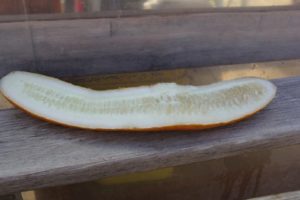Cucumber Seed Production: Quick Reference - Organic Seed Alliance

Cucurbit Seed Production
Cucurbits of the same species will intermate, even if they seem to be disparate types. Isolation distances must be increased for cucurbits of the same species, especially if they produce different fruit types.
| Cucurbita species | Common varieties |
| C. pepo | Acorn, spaghetti, crookneck, delicata, gourds, zucchini, scallop |
| C. moschata | Butternut, golden, orange and orange striped cushaw, cheese |
| C. maxima | Hubbard, buttercup, marrow, turban |
| C. mixta | Cushaws except golden, orange, and orange striped |
| C. sativus | Slicing cucumbers |
| C. melo | Armenian snake cucumber, muskmelons |
Production
Cucumbers, similar to winter squashes, are outcrossing, self-compatible, and insect-pollinated. At least 25 plants should be grown to maintain the genetic integrity of a variety. For summer squashes or cucumbers of the same species, but of different fruit types (e.g., green and blond slicing cucumbers), 1-2 miles is suggested. For similar fruit types (e.g., two different varieties of green slicing cucumbers), 0.5-1 mile may suffice. Cultivation techniques are the same as winter squash, but the seed is mature when the fruits have grown larger than market harvest size and have changed color to a pale or golden yellow.

After the seed is mature, the fruits should be left on the vine for several weeks. As long as the fruit is not rotting, they can be harvested after the first killing frost to make them easier to find. Seed should be collected directly after harvest. A vine harvester or PTO driven hammermill can be used to crush large quantities of fruit. For smaller amounts, chop the fruit in half or into sections and collect the juice and seeds. Unlike winter squashes, fermentation is required for cucumber seed, but no added water is needed. The seed pulp can be placed in a barrel for 24-48 hours at 70-85°F. After fermentation, a wooden sluice can be used to collect heavy seed and remove the pulp. When dried to <6.0% moisture and stored at 40-60°F and <40%RH, seed can be stored for 3-5 years.
Selection and Variety Improvement
To properly evaluate cucumbers, plants must be given enough space in the field so that individual plants can be identified for selection. Record the first flowering date, especially for female flowers and observe the ovary to determine basic fruit shape and spine color. Selections before harvest will increase the speed of variety improvement for the traits selected. Eliminate weak or diseased plants and undesirable fruits. Self-pollinations or intentional crosses will generally result in the fastest progress for desirable fruit quality traits, such as fruit shape, size, color, uniformity and flavor.
| Trait | Timing |
| Soil emergence | After planting |
| Seedling vigor | After planting |
| Length of internodes before flowering | Before flowering |
| Incidence of foliar diseases | Throughout season |
| Leaf characteristics – size, shape, degree of lobing, color | Before flowering |
| Time of flowering – female flowers | |
| Time of flowering – male flowers | |
| Trueness to type of eating stage fruit | Market harvest |
| Fruit shape | Market harvest |
| Fruit size | Market harvest |
| Flavor, texture & eating quality | Market harvest |
Disease
Start with disease-free seed. Use disease-resistant varieties if available. Practice a 3-5 year crop rotation. Scout plants routinely throughout the season to detect disease issues and rogue accordingly. Sanitize greenhouses and remove and bury all crop debris. Avoid overhead irrigation. Diseases are classified by severity with a class of 1 being the most severe and 3 the least severe.
| Disease | Type | Severity class | Favorable conditions |
| Fusarium crown & foot rot (Fusarium solani f. sp. Cucurbitae) | Seedborne | 2 | Cool air temperatures (50-70°F) and soil temperatures from 63-68°F. |
| Cucumber green mottle mosaic virus (CGMMV) | Seedborne | 2 | Greenhouse environment |
| Scab (Cladosporium cucumerinum) | Seedborne | 3 | Moist and cool |
| Fusarium wilt (Fusarium oxysporum f. sp. Cucurbitacearum) | Seedborne | 3 | Cool air temperatures (50-70°F) and soil temperatures from 63-68°F. |
| Squash mosaic virus (SqMV) | Seedborne | 1 | Presence of spotted cucumber beetle and related species |
| Gummy stem blight (Didymella bryoniae) | Seedborne | 1 | 75-77°F for 12 hours & high humidity (>85% RH) |
| Bacterial leaf spot (Xanthomonas campestris pv. cucurbitae) | Seedborne | 2 | High temperature (77-86°F) and high humidity |
| Anthracnose (Colletotrichum orbiculare) | Foliar | 2 | Warm, wet weather |
This resource was made possible thanks to the Montana Department of Agriculture’s Specialty Crop Block Grant Program.

